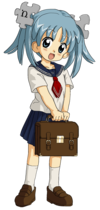Portal:Anime and manga - Wikipedia
 |
Welcome to The Anime and Manga Portal |
 |
 |
 |
 |

|
Introduction

Anime (アニメ) refers to the animation style originating in Japan. It is characterized by distinctive characters and backgrounds (hand-drawn or computer-generated) that visually and thematically set it apart from other forms of animation. Storylines may include a variety of fictional or historical characters, events, and settings. Anime is aimed at a broad range of audiences; consequently, a given series may have aspects of a range of genres. Anime is most frequently distributed by streaming services, broadcast on television, or sold on DVDs and other media, either after their broadcast run or directly as original video animation (OVA). Console and computer games sometimes also feature segments or scenes that can be considered anime.
Manga (漫画) is Japanese for "comics" or "whimsical images". Manga developed from a mixture of ukiyo-e and Western styles of drawing, and took its current form shortly after World War II. Manga, apart from covers, is usually published in black and white but it is common to find introductions to chapters to be in color and read from top to bottom and then right to left, similar to the layout of a Japanese plain text. Financially, manga represented 2005 a market of ¥24 billion in Japan and $180 million in the United States. Manga was the fastest-growing segment of books in the United States in 2005. In 2020, Japan's manga industry hit a value of ¥612.6 billion due to the fast growth of the digital manga market, while manga sales in North America reached an all-time high at almost $250 million.
Anime and manga share many characteristics, including exaggerating (in terms of scale) of physical features, to which the reader presumably should pay most attention (best known being "large eyes"), "dramatically shaped speech bubbles, speed lines and onomatopoeic, exclamatory typography..." Some manga (a small percentage) are adapted into anime, often with the collaboration of the original author. Computer games can also be adapted into anime. In such cases, the work's original story is often compressed or modified to fit the new format and appeal to a wider demographic. Popular anime franchises sometimes include full-length feature films. Some anime franchises have been adapted into live-action films and television programs.
Selected article
Katsudō Shashin is a filmstrip speculated to be the oldest work of animation in Japan. Three seconds long, it depicts a boy who writes "moving picture" in Japanese script, removes his hat, and waves. Discovered in a collection of films and projectors in Kyoto, its creator is unknown. Natsuki Matsumoto, an expert in iconography at the Osaka University of Arts, determined that it was most likely made before 1912. It may have been influenced by animated filmstrips for German cinematographs, devices that first appeared in Japan in 1904. Evidence suggests Katsudō Shashin was mass-produced to be sold to wealthy owners of home projectors. To Matsumoto, the relatively poor quality and low-tech printing technique indicate it was likely from a smaller film company. Unlike in traditional animation, the frames were not produced by photographing the images, but were impressed directly onto film. They were stencilled in red and black using a device for making magic lantern slides, and the filmstrip was fastened in a loop for continuous play. (Full article...)
Featured list
The episodes of the Black Lagoon anime are based on the manga series of the same name by Rei Hiroe. The episodes of the first season of the anime were directed by Sunao Katabuchi, animated by Madhouse Studios, and produced by Geneon Entertainment and Shogakukan. In the second season, known as Black Lagoon: The Second Barrage, Shogakukan was not involved in the production. The English adaptation of the episodes is licensed by Geneon Entertainment. The plot of the episodes follows the adventures of a Japanese businessman, Rokuro Okajima, after he is abducted by the members of the ship Black Lagoon and joins their crew under the moniker "Rock".
The first season aired from April 8, 2006, to June 24, 2006, on Chiba TV in Japan. The second season began airing on October 3, 2006, on KBS Kyoto, TV Nagoya, TV Kanagawa, and Sun TV, and concluded its run on December 19, 2006. The English adaptations of both seasons were aired continuously from October 26, 2007, to April 11, 2008, on G4techTV Canada; the English episodes were also broadcast in the United States from February 26, 2008, to May 13, 2008, on Starz Edge. (Full list...)
Did you know...
- ... that Queen Millennia was combined by Harmony Gold and Carl Macek with another Leiji Matsumoto series, Captain Harlock, to create Captain Harlock and the Queen of a Thousand Years?
- ... that while the anime adaptation of the Japanese visual novel White Album began its broadcast in 2009, it was actually first considered in 1998?
- ... that AfterEllen.com praised the yaoi manga series The Moon and the Sandals for illustrating "the challenges gay men face in Japanese society"?
- ... that Sabu to Ichi Torimono Hikae, a manga about a blind samurai, won the 1968 Shogakukan Manga Award?
- ... that Chikara to Onna no Yo no Naka, released in 1933 and directed by Kenzō Masaoka, was the first "talkie" animated film in Japan?

